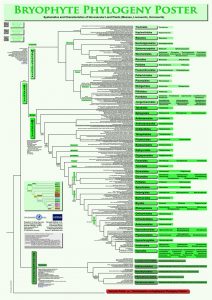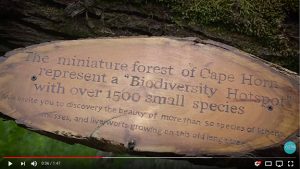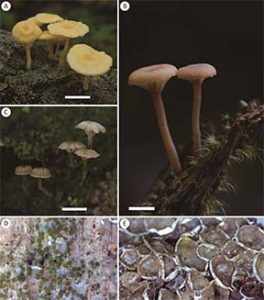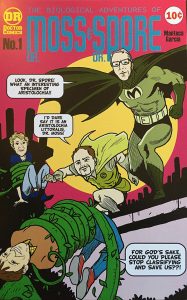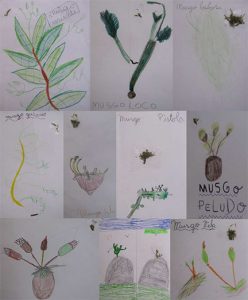 Lily Lewis who earned her Ph.D. in EEB and was engaged the biocultural conservation course held annually on Navarino, Chile, published a study focused on Cultivating a garden of names.
Lily Lewis who earned her Ph.D. in EEB and was engaged the biocultural conservation course held annually on Navarino, Chile, published a study focused on Cultivating a garden of names.
Lewis L.R., C. Gottschalk Druschke, C. Saldías, R. Mackenzie, B. Goffinet & R. Rozzi. 2018. Cultivando un jardín de nombres en los bosques en miniature del Cabo de Hornos: extensión de la conservación biocultural y la ética a seres vivos poco percibidos (Cultivating a Garden of Names in the Miniature Forests of Cape Horn: an extension of biocultural conservation and ethics to under-perceived beings). Magallania 46: 103–123. pdf
The abstract reads (in Spanish first and English below!):
Las briófitas (musgos, hepáticas y antocerotes) y los líquenes han sido subvalorados en los programas de conservación y educación ambiental, y por la cultura moderna en general. Tanto es así, que la mayoría de las briofitas y líquenes carecen de un nombre común. Aquí presentamos una nueva metodología y actividad para fomentar una comprensión ecológica de la biodiversidad, como también de la conservación y la ética biocultural, que incluya a seres vivos pequeños y poco percibidos; tales como las briófitas. Si algo no tiene nombre, entonces no existe en el ámbito cultural. Si algo se nombra, entonces sí existe en la esfera cultural; además, su existencia queda decisivamente influida por su nombre. En el extremo sur del continente americano, la Reserva de la Biosfera Cabo de Hornos de la UNESCO en Chile protege un “hotspot” o centro mundial de diversidad de briofitas. Aquí el equipo de investigación en el Parque Etnobotánico Omora ha desarrollado una innovadora actividad educativa y de ecoturismo para apreciar las briofitas: Cultivando un Jardín de Nombres. Esta actividad se ha desarrollado bajo la aproximación metodológica de la Filosofía Ambiental de Campo (FILAC), que anima a estudiantes y visitantes a observar y apreciar tanto biofísica como culturalmente (incluyendo la dimensión simbólico-lingüística) la existencia de las briófitas y líquenes, sus hábitos de vida y sus hábitats. Los participantes son invitados a observar, dibujar y crear nombres para las briofitas y líquenes utilizando: (i) una lupa de mano para amplificar las características biofísicas de las plantas pequeñas y (ii) los lentes conceptuales de la ética biocultural para amplificar la comprensión acerca de cómo interpretar y respetar el mundo natural. A través de esta actividad, los participantes se conectan a seres vivos que eran antes poco percibidos y comienzan a visualizar, valorar y cuidar una realidad biofísica y cultural que es diversa, hermosa, y cumple funciones ecológicas que son esenciales para la integridad de los ecosistemas y el bienestar humano. Cultivando un Jardín de Nombres promueve un cambio de perspectiva científica y ética para incluir a grupos de seres vivos poco percibidos en las metas de conservación y educación ambiental.
Bryophytes (mosses, liverworts, and hornworts) and lichens have been undervalued in conservation and environmental education programs, and by modern culture in general. So much so, that most bryophytes and lichens lack a common name. We present a new methodology and activity to foster an ecological understanding of biodiversity, as well as of biocultural conservation and ethics, which includes little, under-perceived, living-beings –such as bryophytes. If something has no name, it does not exist in the cultural realm. If something is named, then it exists in the cultural sphere; additionally, its existence is decisively influenced by its name. At the southern end of the Americas, the UNESCO Cape Horn Biosphere Reserve in Chile protects a world’s biodiversity hotspot for bryophytes. Here, the research team at the Omora Ethnobotanical Park has developed an innovative educational and ecotourism activity to appreciate bryophytes: Cultivating a garden of names. This activity has been developed with the methodological approach of Field Environmental Philosophy. It encourages students and park’s visitors to engage physically as well as culturally (including the symbolic-linguistic dimension) with bryophytes and lichens, their life-habits and habitats. Park’s visitors are invited to observe, draw, and create names for bryophytes and lichens by using: (i) a magnifying glass or hand-lens to amplify the biophysical features of small plants, and (ii) the conceptual lenses of the biocultural ethics to broaden their understanding about how to interpret and respect the natural world. Through this activity, visitors connect to living beings that were previously under-perceived, and they come to see, value and care for a biophysical reality that is diverse, beautiful, and performs ecological functions that are essential to ecosystem integrity and human well-being. Cultivating a garden of names fosters a change of scientific and ethical perspectives to include little-perceived groups of organisms into the goals of conservation and environmental education.
